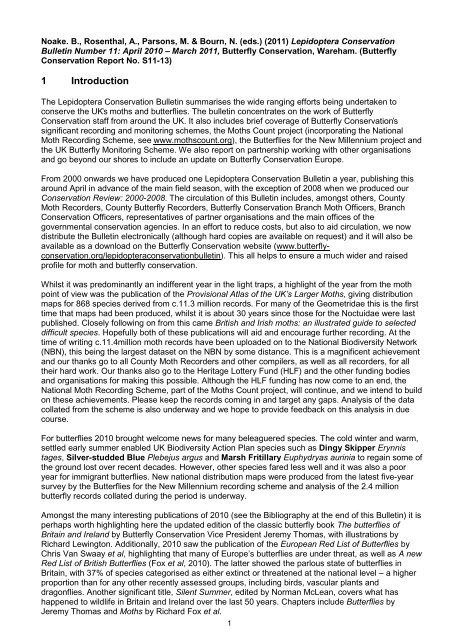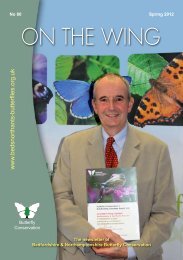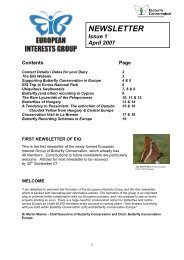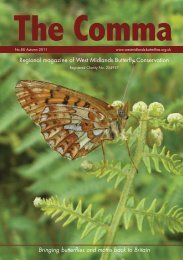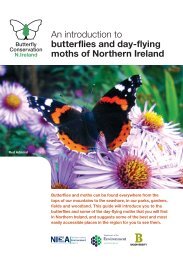Lepidoptera Conservation Bulletin 2011 - Butterfly Conservation
Lepidoptera Conservation Bulletin 2011 - Butterfly Conservation
Lepidoptera Conservation Bulletin 2011 - Butterfly Conservation
You also want an ePaper? Increase the reach of your titles
YUMPU automatically turns print PDFs into web optimized ePapers that Google loves.
Noake. B., Rosenthal, A., Parsons, M. & Bourn, N. (eds.) (<strong>2011</strong>) <strong>Lepidoptera</strong> <strong>Conservation</strong><br />
<strong>Bulletin</strong> Number 11: April 2010 – March <strong>2011</strong>, <strong>Butterfly</strong> <strong>Conservation</strong>, Wareham. (<strong>Butterfly</strong><br />
<strong>Conservation</strong> Report No. S11-13)<br />
1 Introduction<br />
The <strong>Lepidoptera</strong> <strong>Conservation</strong> <strong>Bulletin</strong> summarises the wide ranging efforts being undertaken to<br />
conserve the UK’s moths and butterflies. The bulletin concentrates on the work of <strong>Butterfly</strong><br />
<strong>Conservation</strong> staff from around the UK. It also includes brief coverage of <strong>Butterfly</strong> <strong>Conservation</strong>’s<br />
significant recording and monitoring schemes, the Moths Count project (incorporating the National<br />
Moth Recording Scheme, see www.mothscount.org), the Butterflies for the New Millennium project and<br />
the UK <strong>Butterfly</strong> Monitoring Scheme. We also report on partnership working with other organisations<br />
and go beyond our shores to include an update on <strong>Butterfly</strong> <strong>Conservation</strong> Europe.<br />
From 2000 onwards we have produced one <strong>Lepidoptera</strong> <strong>Conservation</strong> <strong>Bulletin</strong> a year, publishing this<br />
around April in advance of the main field season, with the exception of 2008 when we produced our<br />
<strong>Conservation</strong> Review: 2000-2008. The circulation of this <strong>Bulletin</strong> includes, amongst others, County<br />
Moth Recorders, County <strong>Butterfly</strong> Recorders, <strong>Butterfly</strong> <strong>Conservation</strong> Branch Moth Officers, Branch<br />
<strong>Conservation</strong> Officers, representatives of partner organisations and the main offices of the<br />
governmental conservation agencies. In an effort to reduce costs, but also to aid circulation, we now<br />
distribute the <strong>Bulletin</strong> electronically (although hard copies are available on request) and it will also be<br />
available as a download on the <strong>Butterfly</strong> <strong>Conservation</strong> website (www.butterflyconservation.org/lepidopteraconservationbulletin).<br />
This all helps to ensure a much wider and raised<br />
profile for moth and butterfly conservation.<br />
Whilst it was predominantly an indifferent year in the light traps, a highlight of the year from the moth<br />
point of view was the publication of the Provisional Atlas of the UK’s Larger Moths, giving distribution<br />
maps for 868 species derived from c.11.3 million records. For many of the Geometridae this is the first<br />
time that maps had been produced, whilst it is about 30 years since those for the Noctuidae were last<br />
published. Closely following on from this came British and Irish moths: an illustrated guide to selected<br />
difficult species. Hopefully both of these publications will aid and encourage further recording. At the<br />
time of writing c.11.4million moth records have been uploaded on to the National Biodiversity Network<br />
(NBN), this being the largest dataset on the NBN by some distance. This is a magnificent achievement<br />
and our thanks go to all County Moth Recorders and other compilers, as well as all recorders, for all<br />
their hard work. Our thanks also go to the Heritage Lottery Fund (HLF) and the other funding bodies<br />
and organisations for making this possible. Although the HLF funding has now come to an end, the<br />
National Moth Recording Scheme, part of the Moths Count project, will continue, and we intend to build<br />
on these achievements. Please keep the records coming in and target any gaps. Analysis of the data<br />
collated from the scheme is also underway and we hope to provide feedback on this analysis in due<br />
course.<br />
For butterflies 2010 brought welcome news for many beleaguered species. The cold winter and warm,<br />
settled early summer enabled UK Biodiversity Action Plan species such as Dingy Skipper Erynnis<br />
tages, Silver-studded Blue Plebejus argus and Marsh Fritillary Euphydryas aurinia to regain some of<br />
the ground lost over recent decades. However, other species fared less well and it was also a poor<br />
year for immigrant butterflies. New national distribution maps were produced from the latest five-year<br />
survey by the Butterflies for the New Millennium recording scheme and analysis of the 2.4 million<br />
butterfly records collated during the period is underway.<br />
Amongst the many interesting publications of 2010 (see the Bibliography at the end of this <strong>Bulletin</strong>) it is<br />
perhaps worth highlighting here the updated edition of the classic butterfly book The butterflies of<br />
Britain and Ireland by <strong>Butterfly</strong> <strong>Conservation</strong> Vice President Jeremy Thomas, with illustrations by<br />
Richard Lewington. Additionally, 2010 saw the publication of the European Red List of Butterflies by<br />
Chris Van Swaay et al, highlighting that many of Europe’s butterflies are under threat, as well as A new<br />
Red List of British Butterflies (Fox et al, 2010). The latter showed the parlous state of butterflies in<br />
Britain, with 37% of species categorised as either extinct or threatened at the national level – a higher<br />
proportion than for any other recently assessed groups, including birds, vascular plants and<br />
dragonflies. Another significant title, Silent Summer, edited by Norman McLean, covers what has<br />
happened to wildlife in Britain and Ireland over the last 50 years. Chapters include Butterflies by<br />
Jeremy Thomas and Moths by Richard Fox et al.<br />
1


